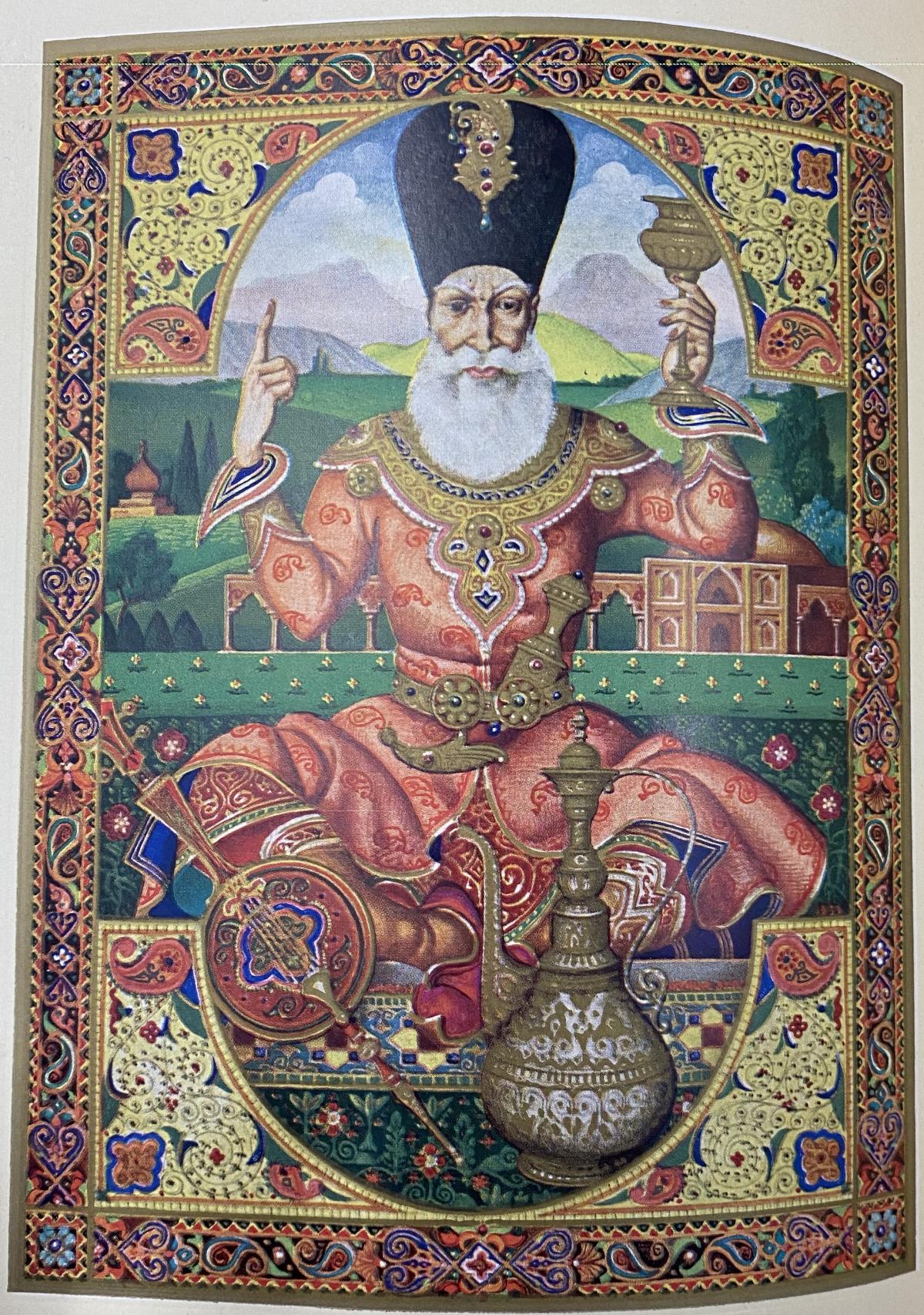This First Edition FitzGerald's translation of the Rubáiyát of Omar Khayyám was published in 1946 by The Heritage Press in New York. Edward FitzGerald first published his translation of the Rubáiyát of Omar Khayyám in 1859. As the first of five editions, this 1946 version of the Rubáiyát of Omar Khayyám carries FitzGerald's original translations and 75 Quatrains. How it differs though, as many of the first editions do, is through its illustrations.
In 1946, The Heritage Press in New York published a First Edition of Edward FitzGerald's translation of the Rubáiyát of Omar Khayyám. Before publishing, this particular book was illustrated by Arthur Szyk (1894 -1951). Syzk was a polish born Jewish artist who created thousands of illustrations over his lifetime and who was immensely popular in the United States and Europe throughout his career as an illustrator.
Szyk's was mostly known for his caricatures and political drawings he created during the various wars and conflicts that arose during his life. The Arthur Szyk website - www.szyk.com - describes Szyk as an "unparalleled artist and illuminator, a proud son of Poland, and a self-described “soldier in art” who used his pen and brush to advocate for religious tolerance, racial equality and human dignity. Active in the years leading up to World War II and during the Holocaust, Szyk became one of America’s most celebrated political artists for his powerful artistic and social contributions against fascism" (Szyk, 2023).
Szyk was commissioned to illustrate the 1946 First Edition of the Rubáiyát of Omar Khayyám by a gentleman named George Macy. Macy was an American publisher whose company, George Macy Companies, Ltd, founded The Heritage Press in 1935 as an imprint to publish classics made more affordable to the public. The Heritage Press (figure 2) took over printing works originally published under Macy's Limited Editions Club. According to Joseph Ansell's book, Arthur Szyk: Artist, Jew, Pole, before forming The Heritage Press, Macy had two subscription book clubs where he "produced elaborately designed and illustrated volumes of literary classics: the American equivalents of, and the heirs to, the deluxe books published in Europe during the 1920s" (Ansell, 106).
What was unique about Macy's classics were the illustrations and the illustrators he commissioned - "The books were specially designed with careful attention to typography and printing, and enhanced with unique bindings and matching slipcases" (106). Macy first saw Arthur Szyk's work at the World’s Fair and upon meeting him at London's Arlington's Gallery, he was able to commission him to illustrate eight miniature paintings for the Rubáiyát.
Some of Szyk's work that he is known for are the illustrations he created for The Haggadah, and the popular ‘George Washington and his Times’ illustrations. Szyk’s Rubáiyát illustrations were printed by the Sun Engraving Company (figure 3). They were created from six colors and gold before being pasted into the double-leafed pages of the book. Interestingly, the first of Szyk’s eight illustrations is a portrait of Omar Khayyám (Figure 1). When comparing his previous work with the eight illustrations of the Rubáiyát, it is clear that Szyk's has a signature style, said to partly be inspired by renaissance art, but according to Ansell's book, Szyk's illustrations "are decidedly more Persian in influence than Szyk’s other works from this period" do to being "influenced both by the subject-matter and by Macy’s expressed desire, the paintings" (106). This is supported by the details in each illustration including the oriental-derived designs along the borders, the details in the architecture and geometric patterns, as well as the Arabic calligraphy - "Szyk’s careful historical research for this project is evident not only in these visual details but also in his use of Arabic calligraphy in several of the illustrations" (106).
This version of the Rubáiyát was printed through The Heritage Press in order to make it more accessible to the public. Although the images are very elaborate, the book itself was made from cheaper materials, such as the cardboard cover and cloth binding (figure 4). Before The Heritage Press, Macy's company would have likely bound the book in leather with a more elaborate cover and higher quality paper on the inside. However, The Heritage Press was created to put out quality material in a way that it could still be accessed by the quantities. And that’s just what it did. Through Heritage Press, people who couldn't normally afford the classic could now purchase a beautiful version of Rubáiyát of Omar Khayyám.
ANSELL, JOSEPH P. “From The Haggadah to The Rubáiyát.” Arthur Szyk: Artist, Jew, Pole, Liverpool University Press, 2004, pp. 92–108. JSTOR, https://doi.org/10.2307/j.ctv1rmjr5.12. Accessed 2 June 2023.
Khayyám Omar. The Rubáiyát of Omar Khayyám Rendered in English Verse by Edward FitzGerald. The Heritage Press, New York. Copyright 1946. Illustrations by Arthur Szyk. Sun Engraving Company. Franfare Press, London.
Arthur Szyk Master Illuminator and Artist. "Arthur Szyk 1894 - 1951". www.szyk.com.





